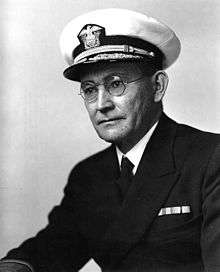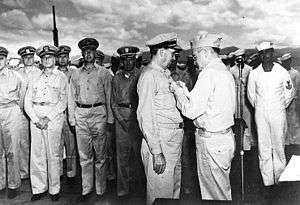Willis Augustus Lee
Willis Augustus "Ching" Lee Jr. (May 11, 1888 – August 25, 1945) was a vice admiral of the United States Navy during World War II. Lee commanded the American ships during the second night of the Naval Battle of Guadalcanal (November 14–15, 1942) and turned back a Japanese invasion force headed for the island. The victory ended Japanese attempts to reinforce their troops on Guadalcanal, and thus marked a turning point in both the Guadalcanal Campaign and the Pacific War itself.
Willis Augustus Lee Jr. | |
|---|---|
 Rear Admiral Willis A. Lee Jr., circa 1942. | |
| Nickname(s) | Ching |
| Born | May 11, 1888 Natlee, Kentucky |
| Died | August 25, 1945 (aged 57) USS Wyoming (BB-32), off the coast of Maine |
| Place of burial | |
| Allegiance | |
| Service/ | |
| Years of service | 1908–1945 |
| Rank | |
| Commands held | USS Fairfax USS William B. Preston USS Lardner USS Pennsylvania USS Concord USS Washington Battleship Division 6 Battleships Pacific Fleet |
| Battles/wars | Occupation of Veracruz World War I |
| Awards | Navy Cross Legion of Merit Distinguished Service Medal (2) |
Lee was also a skilled sport shooter, and won seven medals in the 1920 Olympics shooting events (including five gold medals), tied with teammate Lloyd Spooner for the most anyone had ever received in a single games. Their record stood for 60 years. He was the most successful athlete at the 1920 Olympics.
Early life
The son of Judge Willis Augustus Lee and Susan Arnold, he was known as "Mose" Lee to family and friends.[1][2]
He entered the U.S. Naval Academy in 1904. While at the Naval academy, his Chinese-sounding last name, compounded by his fondness for the Far East earned him the nickname "Ching" Lee.[3]
Following graduation, Lee joined the academy's rifle team twice. He was assigned to the battleship Idaho from October 1908 to May 1909, before returning to the naval academy and re-joining the rifle team. From November 1909 until May 1910, Lee served aboard the protected cruiser New Orleans, and then transferred to the gunboat Helena. Upon being detached back to the United States, Lee re-joined the Academy shooting team a third time. In July 1913, Lee re-joined Idaho, and in April 1914 he transferred to the battleship New Hampshire to participate in the occupation of Veracruz.[4]
During World War I, Lee served on the destroyers O'Brien and Lea.
1920 Olympics
| Medal record | ||
|---|---|---|
| Men's shooting | ||
| Representing the | ||
| Olympic Games | ||
| 1920 Antwerp | Team 50 m small bore rifle | |
| 1920 Antwerp | Team 300 m army rifle, prone | |
| 1920 Antwerp | Team 600 m free rifle | |
| 1920 Antwerp | Team free rifle, 300 m + 600 m | |
| 1920 Antwerp | Team free rifle | |
| 1920 Antwerp | Team 300 m army rifle, standing | |
| 1920 Antwerp | Team 100 m running deer, single shots | |
Lee participated in 14 events at the 1920 Summer Olympics in Antwerp. He won 7 medals (5 gold, 1 silver, and 1 bronze), all in team events.[5] His teammates for the various events were Dennis Fenton, Lawrence Nuesslein, Arthur Rothrock, Oliver Schriver, Morris Fisher, Carl Osburn, Lloyd Spooner, and Joseph Jackson.
Lee and Spooner ended the 1920 Olympics with 7 medals each, the most anyone had ever received in a single games. Boris Shakhlin was the next person to reach 7, in 1960. It would not be until Alexander Dityatin in the 1980 games that anyone would beat the record.
Interwar years
Lee attended the Naval War College in the late 1920s,[5] and was promoted to the rank of captain in 1936.[6]
During the 1930s and early 1940s, Lee was several times assigned to the Fleet Training Division, commanded the light cruiser Concord, and served on the staff of Commander, Cruisers, Battle Force. In early 1942, following his promotion to the rank of rear admiral, Lee became Assistant Chief of Staff to the Commander in Chief, U.S. Fleet.
World War II
Lee's specialty in life was gunnery. At the age of 19 in 1907 "he became the only American to win both the US National High Power Rifle and Pistol championships in the same year." In 1914 during the Veracruz campaign in Mexico he drew the fire of three enemy snipers, thereby exposing their positions and then shot them at long range.[3] He understood the powerful guns of a battleship as an extension of the law of ballistics and adapted his expertise to the new age of technology.[7] When Admiral Lee engaged the Japanese Vice Admiral Nobutake Kondō's battleship Kirishima on the evening of 14 November 1942 in the waters off Guadalcanal, he became naval history's first battleship commander to conduct a "gunfight" primarily by radar remote control.[8]
Naval Battle of Guadalcanal

In August 1942, Rear Admiral Lee was sent to the Pacific to command Battleship Division Six, consisting of the battleships Washington and South Dakota. Flying his flag in Washington, Lee engaged an Imperial Japanese Navy surface fleet under the command of Vice Admiral Kondō during the second night of the Naval Battle of Guadalcanal on the night of 14–15 November 1942. While riding in the battleship Washington, which served as his flagship during this sea-fight, Lee's battleship decisively gunned the battleship Kirishima into a wreck, resulting in her scuttling shortly afterwards. With 300 Imperial sailors still entombed within her hull, she slid into Ironbottom Sound,[9] leaving Admiral Lee's flagship Washington the only American battleship during World War II to sink an enemy battleship in a "one on one" gunfight.[10]
Lee, who "knew more about radar than the radar operators",[11] used the SG radar installed aboard Washington to skillfully maneuver his ships during the night.
To Willis Lee went many accolades. "Audacious planning and execution" marked his operations, commented Halsey... Unlike Callaghan, Lee never allowed the action to degenerate into a nautical brawl, because he formulated a workable plan and adhered to it, even after every ship in his task force except Washington was sunk or forced to retire. Lee was never more incisive than in his own evaluation of his success: "We realized then and it should not be forgotten now, that our entire superiority was due almost entirely to our possession of radar. Certainly we have no edge on the Japs in experience, skill, training, or performance of personnel."
— Richard B. Frank, [12]
After Guadalcanal
Lee was awarded the Navy Cross for his actions at the battle, promoted to vice admiral in 1944 and placed in charge of the Pacific Fleet's fast battleships, as Commander, Battleships, Pacific Fleet (ComBatPac).
In May 1945, he was sent to the Atlantic to command a special unit researching defenses against the threat of Japanese kamikaze aircraft, the Composite Task Force, U.S. Atlantic Fleet. While serving in that position on 25 August 1945, Vice Admiral Willis A. Lee died suddenly after suffering a heart attack, ten days after the Surrender of Japan. He collapsed and died in a motor launch that was ferrying him out to his flagship in the harbor at Portland, Maine.[13]
Family
Willis Lee Jr. was a distant relative of Confederate General Robert E. Lee and the third Attorney General of the United States, Charles Lee.[14] He married Mabelle Allen Elspeth (1894–1949) on July 14, 1919. They had no children.[6] Willis' father, Judge Willis Augustus Lee Sr., was one of fourteen children of Nathaniel Wiley Lee (aka Nat Lee, founder of Natlee) and Frances Abbott, of Owen County, Kentucky. While in the Pacific theater, Lee unofficially adopted two Korean children in Vietnam after the children's family requested that Lee take the children to the United States.[15] While the children were never adopted under United States law due to Lee's heart attack, the adoption was consummated under Korean custom at the time. Both children took Lee's name - Barry Lee and Willis H. Lee - and were permitted to enter the United States with their biological parents. Barry was adopted by a family in Long Island, New York while Willis and his family relocated to Scarsdale, New York. Both now reside in Saratoga Springs.[16]
His great-grandparents were early Kentucky settlers, Joseph R. Lee and Mary Wiley.[17] His grandfather Nathaniel W. Lee operated a distillery at his namesake village of Natlee. In 1893, Nat Lee's sour mash whiskey was taken to the Chicago World's Fair where it won the Gold Medal over 5000 other entries.[18]
Namesakes
The Mitscher-class destroyer USS Willis A. Lee (DD-929) was named for him.
Awards and decorations
Here is the ribbon bar of Vice admiral Willis Augustus Lee:[19]
| 1st Row |
Navy Cross | Navy Distinguished Service Medal with one 5⁄16" Gold Star | |||||||||||
|---|---|---|---|---|---|---|---|---|---|---|---|---|---|
| 2nd Row |
Legion of Merit | Mexican Service Medal | World War I Victory Medal with Destroyer Clasp | ||||||||||
| 3rd Row |
American Defense Service Medal | American Campaign Medal | Asiatic-Pacific Campaign Medal with five 3/16 inch service stars | ||||||||||
| 4th Row |
World War II Victory Medal | Grand Cordon of the Order of the Cloud and Banner | Philippine Liberation Medal with two stars | ||||||||||
References
Citations
- Miriam Sidebottom Houchens. History of Owen County, Kentucky. Owen County Historical Society, 1976. p. 305
- James C. Bryant. Mountain Island In Owen County, Kentucky: The Settlers And Their Churches. Owen County Historical Society, 1986, p. 45
- Hornfischer p. 347
- "Willis A. Lee". hazegray.org. Retrieved September 1, 2010.
- "Willis A. Lee". Dictionary of American Naval Fighting Ships. Navy Department, Naval History and Heritage Command. Retrieved September 1, 2010.
- "Willis Augustus Lee, Vice Admiral, United States Navy". arlingtoncemetery.net. Retrieved September 2, 2010.
- Hornfischer p. 348
- Hornfischer p. 355
- Hornfischer pp. 361-366
- Hornfischer p. 366
- Spector, Ronald H. (1985). Eagle Against The Sun. p. 212. ISBN 978-0-394-74101-7. (Quoted from Samuel Eliot Morison, Struggle for Guadalcanal, p. 270)
- Frank, Richard B. (1990). Guadalcanal: The Definitive Account of the Landmark Battle. New York: Random House. ISBN 0-394-58875-4. Page 486
- Associated Press, "Admiral Lee Dies", The San Bernardino Daily Sun, San Bernardino, California, Sunday 26 August 1945, Volume 51, page 7.
- "Willis Lee Biography". sports-reference.com. Archived from the original on April 17, 2020. Retrieved September 2, 2010.
- "News, Breaking News and More: The Saratogian". www.saratogian.com. Retrieved May 11, 2016.
- "Willis Lee | LinkedIn". www.linkedin.com. Retrieved May 11, 2016.
- Bryant, p. 454
- Bryant, p. 50.
- "Valor awards for Willis Augustus Lee". valor.militarytimes.com. Militarytimes Websites. Retrieved June 19, 2018.
Bibliography
- Hornfischer, James D. (2011). Neptune's Inferno: The US Navy at Guadalcanal. New York City: Bantam Books. ISBN 978-0-553-80670-0.
External links
| Wikimedia Commons has media related to Willis A. Lee. |